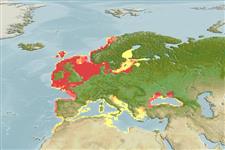分类 / Names
俗名 | 同种异名 | Catalog of Fishes(属, 种) | ITIS | CoL | WoRMS | Cloffa
Teleostei >
Clupeiformes (Herrings) >
Clupeidae (Herrings, shads, sardines, menhadens)
Etymology: Sprattus: Old German, sprotte (1611) = a small fish, Clupea sp. (Ref. 45335).
More on author: Linnaeus.
Environment: milieu / climate zone / depth range / distribution range
生态学
海洋; 半咸淡水; 海洋洄游的 (Ref. 51243); 深度上下限 10 - 150 m (Ref. 6302). 溫帶; 69°N - 30°N, 11°W - 42°E
Northeast Atlantic: North Sea and adjacent waters as far north as the Lofoten Area and the west of the British Isles, and Baltic Sea south to Morocco; also in northern Mediterranean (Gulf of Lion and the Adriatic Sea) and Black Sea.
東北大西洋: 北海與波羅的海南至摩洛哥; 也地中海, 亞得里亞海的與黑海。
Length at first maturity / 大小 / 重量 / 年龄
Maturity: Lm 10.1, range 8 - 12 cm
Max length : 16.0 cm SL 雄鱼/尚未辨别雌雄; (Ref. 188); common length : 12.0 cm SL 雄鱼/尚未辨别雌雄; (Ref. 188); 最大年龄: 6 年 (Ref. 3561)
背棘 (总数): 0; 背的软条 (总数): 13-21; 臀棘 0; 臀鳍软条: 12 - 23. Lower jaw slightly projecting, gill cover without any bony radiating striae, teeth rarely present on vomer; belly with a strong keel of scutes; last two anal fin rays not enlarged. No dark spots on flanks. Pterotic bulla absent.
下颌些微突出, 没有任何的多骨放射陷纹的鳃盖 , 齿很少地位于犁骨之上; 腹面有一个鳞甲的强龙骨脊; 最后两个臀鳍棘条不增大了。 没有在侧面上的深色斑点。 翼的文件印章不存在。
Usually inshore schooling, sometimes entering estuaries (especially the juveniles) and tolerating salinities as low as 4 ppt. Shows strong migrations between winter feeding and summer spawning grounds. Moves to the surface at night. Feeds on planktonic crustaceans (Ref. 9900). Spawns at depths of 10-20 m producing 6,000-14,000 pelagic eggs (Ref. 35388). Some spawn almost throughout the year, mainly in spring and summer, near the coast or up to 100 km out to sea, the young drifting inshore. Sold as 'brislings' to canneries. Sprat are used in the production of fish meal and as mink food, less for human consumption (Ref. 9900). Utilized fresh, smoked, canned and frozen; can be pan-fried and broiled (Ref. 9988).
通常近海群游性, 有时进入河口 (尤其稚鱼) 与容忍盐度更低到 4个 ppt。 在冬天之间显示强烈的回游进食与夏天产卵场。 移动到表面在晚上。 吃浮游性甲壳动物。 (参考文献 9900) 产卵在深度 10-20 公尺生产 6,000-14,000个大洋性的卵。 (参考文献 35388) 一些产卵几乎全年度,主要在春天与夏天, 在海岸或向上到 100 的附近公里向外到海洋, 幼鱼漂流沿海地区。 卖作了到罐头工厂的 '小鲱鱼' 。 鲱鱼被用于鱼粉与当作貂的食物,比较少的供人类消费的生产。 (参考文献 9900) 生鲜使用,烟熏了, 罐装及冷冻; 可能是油锅炸而火烤的。 (参考文献 9988)
Life cycle and mating behavior
成熟度 | 繁殖 | 产卵场 | 卵 | 孕卵数 | 仔鱼
Some spawn almost year round but mainly in spring and summer, near to the coast or up to 100 km out to sea, the young drifting inshore. Individual period of spawning takes about two months (Ref. 92054).東北大西洋: 北海與波羅的海南至摩洛哥; 也地中海, 亞得里亞海的與黑海。
Whitehead, P.J.P., 1985. FAO Species Catalogue. Vol. 7. Clupeoid fishes of the world (suborder Clupeoidei). An annotated and illustrated catalogue of the herrings, sardines, pilchards, sprats, shads, anchovies and wolf-herrings. FAO Fish. Synop. 125(7/1):1-303. Rome: FAO. (Ref. 188)
人类利用
渔业: 高经济性; 诱饵: usually
工具
特别资料
下载 XML
网络资源
Estimates based on models
Preferred temperature (Ref.
123201): 4.3 - 15.3, mean 9.5 °C (based on 530 cells).
Phylogenetic diversity index (Ref.
82804): PD
50 = 0.5312 [Uniqueness, from 0.5 = low to 2.0 = high].
Bayesian length-weight: a=0.00575 (0.00491 - 0.00675), b=3.09 (3.04 - 3.14), in cm total length, based on LWR estimates for this species (Ref.
93245).
营养阶层 (Ref.
69278): 3.0 ±0.07 se; based on food items.
Generation time: 2.2 (1.7 - 2.6) years. Estimated as median ln(3)/K based on 23
growth studies.
回复力 (Ref.
120179): 中等的, 族群倍增时间最少 1.4 - 4.4年 (rm=1.7; K=0.14-0.77; tm=1-2; tmax=6; Fec=2,000 (batch fec)).
Prior r = 0.49, 95% CL = 0.32 - 0.74, Based on 13 stock assessments.
Fishing Vulnerability (Ref.
59153): Low vulnerability (25 of 100).
Climate Vulnerability (Ref.
125649): Low vulnerability (15 of 100).
Nutrients (Ref.
124155): Calcium = 69.8 [34.7, 136.5] mg/100g; Iron = 0.454 [0.171, 1.290] mg/100g; Protein = 19.9 [17.2, 22.6] %; Omega3 = 0.601 [0.328, 1.136] g/100g; Selenium = 8.55 [3.88, 18.40] μg/100g; VitaminA = 66.3 [13.8, 248.5] μg/100g; Zinc = 0.429 [0.200, 1.835] mg/100g (wet weight); based on
nutrient studies.
